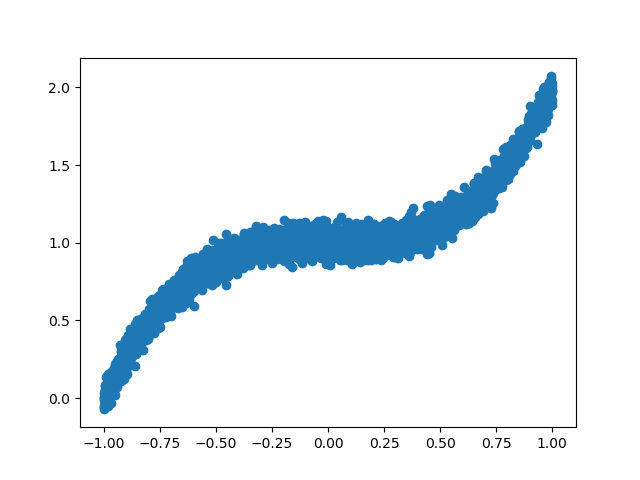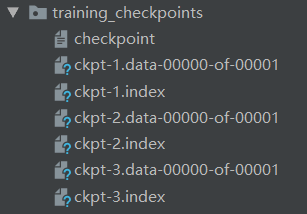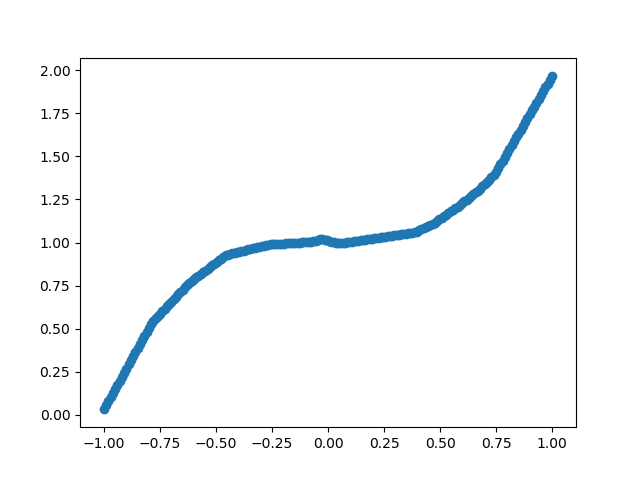[Tensorflow] 使用 tf.train.Checkpoint() 保存 / 加载 keras subclassed model
在 subclassed_model.py 中,通过对 tf.keras.Model 进行子类化,设计了两个自定义模型。
import tensorflow as tf
tf.enable_eager_execution() # parameters
UNITS = 8 class Encoder(tf.keras.Model):
def __init__(self):
super(Encoder, self).__init__()
self.fc1 = tf.keras.layers.Dense(units=UNITS * 2, activation='relu')
self.fc2 = tf.keras.layers.Dense(units=UNITS, activation='relu') def call(self, inputs):
r = self.fc1(inputs)
return self.fc2(r) class Decoder(tf.keras.Model):
def __init__(self):
super(Decoder, self).__init__()
self.fc = tf.keras.layers.Dense(units=1) def call(self, inputs):
return self.fc(inputs)
在 save_subclassed_model.py 中,创建了 5000 组训练数据集,实例化 Encoder()、Decoder() 模型,优化器采用 tf.train.AdamOptimizer(),以均方误差作为 Loss 函数。训练过程中,每 5 个 epoch 保存一次模型。
from subclassed_model import * import numpy as np
import matplotlib.pyplot as plt
import os import tensorflow as tf
tf.enable_eager_execution() # create training data
X = np.linspace(-1, 1, 5000)
np.random.shuffle(X)
y = X ** 3 + 1 + np.random.normal(0, 0.05, (5000,)) # plot data
plt.scatter(X, y)
plt.show() # training dataset
BATCH_SIZE = 16
BUFFER_SIZE = 128 training_dataset = tf.data.Dataset.from_tensor_slices((X, y)).batch(BATCH_SIZE).shuffle(BUFFER_SIZE) # initialize subclassed models
encoder = Encoder()
decoder = Decoder() optimizer = tf.train.AdamOptimizer() # loss function
def loss_function(real, pred):
return tf.losses.mean_squared_error(labels=real, predictions=pred) # training
EPOCHS = 15 # checkpoint
checkpoint_dir = './training_checkpoints'
checkpoint_prefix = os.path.join(checkpoint_dir, 'ckpt')
checkpoint = tf.train.Checkpoint(optimizer=optimizer,
encoder=encoder,
decoder=decoder)
if not os.path.exists(checkpoint_dir):
os.makedirs(checkpoint_dir) for epoch in range(EPOCHS):
epoch_loss = 0 for (batch, (x, y)) in enumerate(training_dataset):
x = tf.cast(x, tf.float32)
y = tf.cast(y, tf.float32)
x = tf.expand_dims(x, axis=1) # tf.Tensor([...], shape=(16, 1), dtype=float32)
y = tf.expand_dims(y, axis=1) # tf.Tensor([...], shape=(16, 1), dtype=float32) with tf.GradientTape() as tape:
y_ = encoder(x)
prediction = decoder(y_)
batch_loss = loss_function(real=y, pred=prediction) grads = tape.gradient(batch_loss, encoder.variables + decoder.variables)
optimizer.apply_gradients(zip(grads, encoder.variables + decoder.variables),
global_step=tf.train.get_or_create_global_step()) epoch_loss += batch_loss if (batch + 1) % 100 == 0:
print('Epoch {} Batch {} Loss {:.4f}'.format(epoch + 1,
batch + 1,
batch_loss.numpy())) print('Epoch {} Loss {:.4f}'.format(epoch + 1, epoch_loss / len(X))) if (epoch + 1) % 5 == 0:
checkpoint.save(file_prefix=checkpoint_prefix)
运行 save_subclassed_model.py。

2019-06-27 12:57:14.253635: I tensorflow/core/platform/cpu_feature_guard.cc:141] Your CPU supports instructions that this TensorFlow binary was not compiled to use: AVX2
2019-06-27 12:57:15.660142: I tensorflow/core/common_runtime/gpu/gpu_device.cc:1432] Found device 0 with properties:
name: GeForce GTX 1060 major: 6 minor: 1 memoryClockRate(GHz): 1.6705
pciBusID: 0000:01:00.0
totalMemory: 6.00GiB freeMemory: 4.97GiB
2019-06-27 12:57:15.660397: I tensorflow/core/common_runtime/gpu/gpu_device.cc:1511] Adding visible gpu devices: 0
2019-06-27 12:57:16.488227: I tensorflow/core/common_runtime/gpu/gpu_device.cc:982] Device interconnect StreamExecutor with strength 1 edge matrix:
2019-06-27 12:57:16.488385: I tensorflow/core/common_runtime/gpu/gpu_device.cc:988] 0
2019-06-27 12:57:16.488476: I tensorflow/core/common_runtime/gpu/gpu_device.cc:1001] 0: N
2019-06-27 12:57:16.488772: I tensorflow/core/common_runtime/gpu/gpu_device.cc:1115] Created TensorFlow device (/job:localhost/replica:0/task:0/device:GPU:0 with 4722 MB memory) -> physical GPU (device: 0, name: GeForce GTX 1060, pci bus id: 0000:01:00.0, compute capability: 6.1)
Epoch 1 Batch 100 Loss 0.1120
Epoch 1 Batch 200 Loss 0.0179
Epoch 1 Batch 300 Loss 0.0347
Epoch 1 Loss 0.0111
Epoch 2 Batch 100 Loss 0.0144
Epoch 2 Batch 200 Loss 0.0097
Epoch 2 Batch 300 Loss 0.0141
Epoch 2 Loss 0.0012
Epoch 3 Batch 100 Loss 0.0060
Epoch 3 Batch 200 Loss 0.0037
Epoch 3 Batch 300 Loss 0.0054
Epoch 3 Loss 0.0007
Epoch 4 Batch 100 Loss 0.0088
Epoch 4 Batch 200 Loss 0.0038
Epoch 4 Batch 300 Loss 0.0093
Epoch 4 Loss 0.0004
Epoch 5 Batch 100 Loss 0.0039
Epoch 5 Batch 200 Loss 0.0044
Epoch 5 Batch 300 Loss 0.0031
Epoch 5 Loss 0.0003
Epoch 6 Batch 100 Loss 0.0025
Epoch 6 Batch 200 Loss 0.0038
Epoch 6 Batch 300 Loss 0.0027
Epoch 6 Loss 0.0002
Epoch 7 Batch 100 Loss 0.0026
Epoch 7 Batch 200 Loss 0.0032
Epoch 7 Batch 300 Loss 0.0041
Epoch 7 Loss 0.0002
Epoch 8 Batch 100 Loss 0.0022
Epoch 8 Batch 200 Loss 0.0031
Epoch 8 Batch 300 Loss 0.0026
Epoch 8 Loss 0.0002
Epoch 9 Batch 100 Loss 0.0040
Epoch 9 Batch 200 Loss 0.0014
Epoch 9 Batch 300 Loss 0.0040
Epoch 9 Loss 0.0002
Epoch 10 Batch 100 Loss 0.0023
Epoch 10 Batch 200 Loss 0.0030
Epoch 10 Batch 300 Loss 0.0038
Epoch 10 Loss 0.0002
Epoch 11 Batch 100 Loss 0.0028
Epoch 11 Batch 200 Loss 0.0020
Epoch 11 Batch 300 Loss 0.0025
Epoch 11 Loss 0.0002
Epoch 12 Batch 100 Loss 0.0027
Epoch 12 Batch 200 Loss 0.0045
Epoch 12 Batch 300 Loss 0.0021
Epoch 12 Loss 0.0002
Epoch 13 Batch 100 Loss 0.0016
Epoch 13 Batch 200 Loss 0.0033
Epoch 13 Batch 300 Loss 0.0024
Epoch 13 Loss 0.0002
Epoch 14 Batch 100 Loss 0.0034
Epoch 14 Batch 200 Loss 0.0028
Epoch 14 Batch 300 Loss 0.0033
Epoch 14 Loss 0.0002
Epoch 15 Batch 100 Loss 0.0019
Epoch 15 Batch 200 Loss 0.0030
Epoch 15 Batch 300 Loss 0.0037
Epoch 15 Loss 0.0002 Process finished with exit code 0
查看 checkpoint_dir 目录下的文件。

在 load_subclassed_model.py 中,创建了 200 组测试数据,加载了 the latest checkpoint 中保存的模型参数,对模型进行了测试。
from subclassed_model import * import numpy as np
import matplotlib.pyplot as plt import tensorflow as tf
tf.enable_eager_execution() # load model
encoder = Encoder()
decoder = Decoder()
optimizer = tf.train.AdamOptimizer() checkpoint_dir = './training_checkpoints' checkpoint = tf.train.Checkpoint(optimizer=optimizer,
encoder=encoder,
decoder=decoder)
checkpoint.restore(tf.train.latest_checkpoint(checkpoint_dir)) # build model
BATCH_SIZE = 16 encoder.build(input_shape=tf.TensorShape((BATCH_SIZE, 1)))
decoder.build(input_shape=tf.TensorShape((BATCH_SIZE, UNITS))) encoder.summary()
decoder.summary() # create validation data
X_test = np.linspace(-1, 1, 200) # validation dataset
val_dataset = tf.data.Dataset.from_tensor_slices(X_test).batch(1) # predict and plot
results = []
for (batch, x) in enumerate(val_dataset):
x = tf.cast(x, tf.float32)
x = tf.expand_dims(x, axis=1)
y_ = encoder(x)
prediction = decoder(y_)
# print(prediction.numpy()[0][0])
results.append(prediction.numpy()[0][0]) # plot results
plt.scatter(X_test, results)
plt.show()
运行 load_subclassed_model.py。

2019-06-27 13:27:40.712260: I tensorflow/core/platform/cpu_feature_guard.cc:141] Your CPU supports instructions that this TensorFlow binary was not compiled to use: AVX2
2019-06-27 13:27:42.105938: I tensorflow/core/common_runtime/gpu/gpu_device.cc:1432] Found device 0 with properties:
name: GeForce GTX 1060 major: 6 minor: 1 memoryClockRate(GHz): 1.6705
pciBusID: 0000:01:00.0
totalMemory: 6.00GiB freeMemory: 4.97GiB
2019-06-27 13:27:42.106200: I tensorflow/core/common_runtime/gpu/gpu_device.cc:1511] Adding visible gpu devices: 0
2019-06-27 13:27:42.921364: I tensorflow/core/common_runtime/gpu/gpu_device.cc:982] Device interconnect StreamExecutor with strength 1 edge matrix:
2019-06-27 13:27:42.921510: I tensorflow/core/common_runtime/gpu/gpu_device.cc:988] 0
2019-06-27 13:27:42.921594: I tensorflow/core/common_runtime/gpu/gpu_device.cc:1001] 0: N
2019-06-27 13:27:42.921777: I tensorflow/core/common_runtime/gpu/gpu_device.cc:1115] Created TensorFlow device (/job:localhost/replica:0/task:0/device:GPU:0 with 4722 MB memory) -> physical GPU (device: 0, name: GeForce GTX 1060, pci bus id: 0000:01:00.0, compute capability: 6.1)
_________________________________________________________________
Layer (type) Output Shape Param #
=================================================================
dense (Dense) multiple 32
_________________________________________________________________
dense_1 (Dense) multiple 136
=================================================================
Total params: 168
Trainable params: 168
Non-trainable params: 0
_________________________________________________________________
_________________________________________________________________
Layer (type) Output Shape Param #
=================================================================
dense_2 (Dense) multiple 9
=================================================================
Total params: 9
Trainable params: 9
Non-trainable params: 0
_________________________________________________________________ Process finished with exit code 0
版权声明:本文为博主原创文章,欢迎转载,转载请注明作者及原文出处!
[Tensorflow] 使用 tf.train.Checkpoint() 保存 / 加载 keras subclassed model的更多相关文章
- [Tensorflow] 使用 model.save_weights() 保存 / 加载 Keras Subclassed Model
在 parameters.py 中,定义了各类参数. # training data directory TRAINING_DATA_DIR = './data/' # checkpoint dire ...
- docker 保存 加载(导入 导出镜像
tensorflow 的docker镜像很大,pull一次由于墙经常失败.其实docker 可以将镜像导出再导入. 保存加载(tensorflow)镜像 1) 查看镜像 docker images 如 ...
- 优化tableView加载cell与model的过程
优化tableView加载cell与model的过程 效果图 说明 1. 用多态的特性来优化tableView加载cell与model的过程 2. swift写起来果然要比Objective-C简洁了 ...
- TensorFlow:tf.train.Saver()模型保存与恢复
1.保存 将训练好的模型参数保存起来,以便以后进行验证或测试.tf里面提供模型保存的是tf.train.Saver()模块. 模型保存,先要创建一个Saver对象:如 saver=tf.train.S ...
- tensorflow的tf.train.Saver()模型保存与恢复
将训练好的模型参数保存起来,以便以后进行验证或测试.tf里面提供模型保存的是tf.train.Saver()模块. 模型保存,先要创建一个Saver对象:如 saver=tf.train.Saver( ...
- tensorflow中 tf.train.slice_input_producer 和 tf.train.batch 函数(转)
tensorflow数据读取机制 tensorflow中为了充分利用GPU,减少GPU等待数据的空闲时间,使用了两个线程分别执行数据读入和数据计算. 具体来说就是使用一个线程源源不断的将硬盘中的图片数 ...
- tensorflow中 tf.train.slice_input_producer 和 tf.train.batch 函数
tensorflow数据读取机制 tensorflow中为了充分利用GPU,减少GPU等待数据的空闲时间,使用了两个线程分别执行数据读入和数据计算. 具体来说就是使用一个线程源源不断的将硬盘中的图片数 ...
- 【转载】 tensorflow中 tf.train.slice_input_producer 和 tf.train.batch 函数
原文地址: https://blog.csdn.net/dcrmg/article/details/79776876 ----------------------------------------- ...
- tensorflow之tf.train.exponential_decay()指数衰减法
exponential_decay(learning_rate, global_steps, decay_steps, decay_rate, staircase=False, name=None) ...
随机推荐
- 分布式可扩展存储系统 BaikalDB
BaikalDB是一个分布式可扩展的存储系统,支持PB级结构化数据的随机实时读写. 提供MySQL接口,支持常用的SELECT,UPDATE,INSERT,DELETE语法.提供各种WHERE过滤.G ...
- Java8-Executors-No.02
import java.util.concurrent.ExecutionException; import java.util.concurrent.ExecutorService; import ...
- HDU 3824/ BZOJ 3963 [WF2011]MachineWorks (斜率优化DP+CDQ分治维护凸包)
题面 BZOJ传送门(中文题面但是权限题) HDU传送门(英文题面) 分析 定义f[i]f[i]f[i]表示在iii时间(离散化之后)卖出手上的机器的最大收益.转移方程式比较好写f[i]=max{f[ ...
- Vue引入非npm的js库
Vue引入非npm的js库 Vue项目有时候需要一些没有export的js库,不能通过import引入,那么使用方法如下 1.可以在index.html页面使用script标签引入,当然也可以使用cd ...
- P5312 [Ynoi2011]D2T1
思路:01trie 按位维护 提交:5边 错因:爆int + 少处理询问时的右端点 题解: 见代码(已经不想说什么了) 代码 //I have my own flg; #include<bits ...
- sublime text 3 3126注册码
—– BEGIN LICENSE —– Michael Barnes Single User License EA7E-821385 8A353C41 872A0D5C DF9B2950 AFF6F6 ...
- luogu 1903 [国家集训队]数颜色 / 维护队列 带修改莫队
十分玄学的数据结构~ code: #include <bits/stdc++.h> #define N 1000006 #define setIO(s) freopen(s".i ...
- C语言学习笔记2-程序基础和变量
本系列文章由jadeshu编写,转载请注明出处.http://blog.csdn.net/jadeshu/article/details/50751977 作者:jadeshu 邮箱: jades ...
- D. Restore Permutation(权值线段树)
D. Restore Permutation time limit per test 2 seconds memory limit per test 256 megabytes input stand ...
- JavaWeb_(Mybatis框架)动态sql_七
系列博文: JavaWeb_(Mybatis框架)JDBC操作数据库和Mybatis框架操作数据库区别_一 传送门 JavaWeb_(Mybatis框架)使用Mybatis对表进行增.删.改.查操作_ ...
